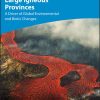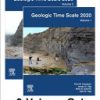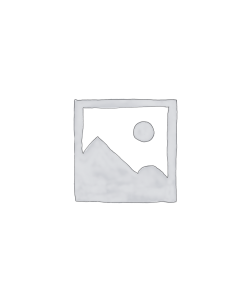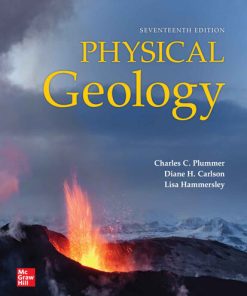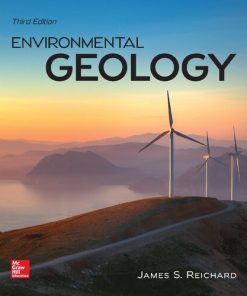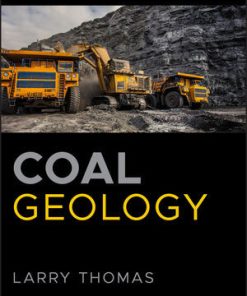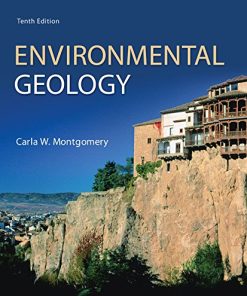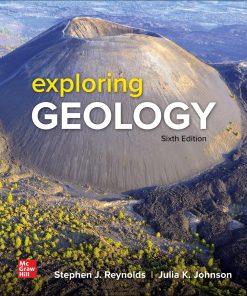Environmental Geology 12th Edition by Carla W. Montgomery 1266716769 9781266716768
$50.00 Original price was: $50.00.$25.00Current price is: $25.00.
Environmental Geology 12th Edition by Carla W. Montgomery – Ebook PDF Instant Download/DeliveryISBN: 1266716769 9781266716768
Full download Environmental Geology 12th Edition after payment.
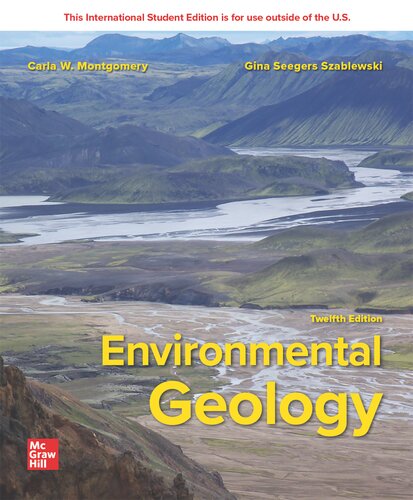
Product details:
ISBN-10 : 1266716769
ISBN-13 : 9781266716768
Author : Carla W. Montgomery
Environmental Geology presents the student with a broad overview of environmental geology. The text looks both at how the earth developed into its present condition and where matters seem to be moving for the future. It is hoped that this knowledge will provide the student with a useful foundation for discussing and evaluating specific environmental issues, as well as for developing ideas about how the problems should be solved.
Environmental Geology 12th Table of contents:
section I Foundations
section II Internal Processes
section III Surface Processes
section IV Resources
section V Waste Disposal, Pollution, and Health
section VI OTHER RELATED TOPICS
Chapter 1: Planet and Population
Chapter 1 Introduction
1.1 Earth in Space and Time
The Early Solar System
The Planets
Earth’s Internal Structure and Atmosphere
Life on Earth
1.2 Geology, Past and Present
The Geologic Perspective
Geology and the Scientific Method
The Motivation to Find Answers
Earth Cycles and Systems
1.3 Nature and Rate of Population Growth
Growth Rates: Causes and Consequences
Growth Rate and Doubling Time
1.4 Impacts of the Human Population
Farmland and Food Supply
Carrying Capacity
Uneven Distribution of People and Resources
Disruption of Natural Systems
Case Study 1.1
Summary
Key Terms and Concepts
Test Your Learning
Exploring Further
Chapter 2: Rocks and Minerals
Chapter 2 Introduction
2.1 Chemistry Basics
Atomic Structure
Elements and Isotopes
Ions
The Periodic Table
Compounds and Bonding
2.2 Fundamentals of Minerals
Minerals Defined
Characteristics of Minerals
Other Physical Properties of Minerals
2.3 Types of Minerals
Silicates
Nonsilicates
2.4 Rocks
Igneous Rocks
Sediments and Sedimentary Rocks
Metamorphic Rocks
The Rock Cycle
Case Study 2.1
Summary
Key Terms and Concepts
Test Your Learning
Exploring Further
Chapter 3: Plate Tectonics
Chapter 3 Introduction
3.1 Continental Drift
Evidence of Drift
3.2 More Evidence for Moving Continents
The Topography of the Sea Floor
Magnetism in Rocks
Paleomagnetism and Seafloor Spreading
Age of the Ocean Floor
Polar-Wander Curves
3.3 Plate Tectonics—Underlying Concepts
Stress and Strain in Geologic Materials
Lithosphere and Asthenosphere
Locating Plate Boundaries
3.4 Types of Plate Boundaries
Divergent Plate Boundaries
Convergent Plate Boundaries
Transform Boundaries
3.5 Moving the Plates
Past Motions, Present Velocities
Why Do Plates Move?
3.6 Plate Tectonics and the Rock Cycle
Case Study 3.1
Summary
Key Terms and Concepts
Test Your Learning
Exploring Further
Chapter 4: Earthquakes
Chapter 4 Introduction
4.1 Earthquakes—Terms and Principles
Basic Terms
Types of Faults
Earthquake Locations
4.2 Seismic Waves and Earthquake Severity
Seismic Waves
Locating the Epicenter
Magnitude and Intensity
4.3 Earthquake-Related Hazards and Their Reduction
Ground Motion
Ground Failure
Tsunamis and Coastal Effects
Broken Lines—Fire, Disease, and Power Loss
4.4 Prediction, Forecasting, and Warnings
Seismic Gaps
Earthquake Precursors and Prediction
Current Status of Earthquake Prediction
The Earthquake Cycle and Forecasting
Slow-Slip Earthquakes
Earthquake Early Warnings
Public Response to Earthquake Hazards
4.5 Earthquake Control
Induced Seismicity
Seismic Barriers
4.6 Future Earthquakes in North America
Widely Recognized Risks at Plate Boundaries
Intraplate Earthquake Hazard Zones
Case Study 4.1
Case Study 4.2
Summary
Key Terms and Concepts
Test Your Learning
Exploring Further
Chapter 5: Volcanoes
Chapter 5 Introduction
5.1 Magma Sources and Types
Magma composition and behavior
Creating and altering magma
Magma and plate settings
5.2 Locations and Styles of Volcanic Activity
Volcano Location
Continental Fissure Eruptions
Hot Spot Volcanoes
Shield Volcanoes
Cinder Cones and Pyroclastics
Composite Volcanoes
5.3 Hazards Related to Volcanoes
Lava
Pyroclastics
Pyroclastic Flows
Lahars
Toxic Gases
Steam Explosions
Landslides and Collapse
Secondary Effects: Climate and Atmospheric Chemistry
5.4 Issues in Predicting Volcanic Eruptions
Classification of Volcanoes by Activity
The Volcanic Explosivity Index
Volcanic Eruption Precursors
Evacuation as Response to Eruption Predictions
5.5 More on Volcanic Hazards in the United States
Cascade Range
The Aleutians
Long Valley and Yellowstone Calderas
Case Study 5.1
Case Study 5.2
Summary
Key Terms and Concepts
Test Your Learning
Exploring Further
Chapter 6: Streams and Flooding
Chapter 6 Introduction
6.1 The Hydrologic Cycle
6.2 Streams and Their Features
Streams—General
Sediment Transport
Velocity, Gradient, and Base Level
Velocity and Sediment Sorting and Deposition
Channel and Floodplain Evolution
6.3 Flooding
Factors Governing Flood Severity
Flood Characteristics
Flash Floods
Stream Hydrographs
Flood-Frequency Curves
6.4 Consequences of Development in Floodplains
6.5 Strategies for Reducing Flood Hazards
Restrictive Zoning and Floodproofing
Retention Ponds, Diversion Channels
Channelization
Levees
Flood-Control Dams and Reservoirs
Flood History, Flood Warnings
Case Study 6.1
Case Study 6.2
Summary
Key Terms and Concepts
Test Your Learning
Exploring Further
Chapter 7: Coastal Zones and Processes
Chapter 7 Introduction
7.1 Nature of the Coastline
Waves, Tides, and Currents
Sediment Transportation and Deposition
Storms and Coastal Dynamics
7.2 Emergent and Submergent Coastlines
Causes of Long-Term Sea-Level Change
Signs of Changing Relative Sea Level
Present and Future Sea-Level Trends
7.3 Coastal Erosion and Attempts at Stabilization
Beach Erosion, Protection, and Restoration
Cliff Erosion
7.4 Especially Challenging Coastal Environments
Barrier Islands
Estuaries
7.5 Coastal Hazards – Recognition and Costs
Recognition of Coastal Hazards
Costs of Coastal Hazards—Economic and Human
Case Study 7.1
Summary
Key Terms and Concepts
Test Your Learning
Exploring Further
Chapter 8: Mass Movements
Chapter 8 Introduction
8.1 Factors Influencing Slope Stability
Effects of Slope and Materials
Effects of Fluid
Effects of Vegetation
Earthquakes
Quick Clays
8.2 Types and Examples of Mass Wasting
Falls
Slides and Slumps
Flows and Avalanches
Mass Wasting Examples
8.3 Impact of Human Activities
8.4 Recognition, Prevention, and Monitoring
Recognizing the Hazards
Slope Stabilization
Landslide Monitoring
Case Study 8.1
Summary
Key Terms and Concepts
Test Your Learning
Exploring Further
Chapter 9: Ice and Glaciers, Wind and Deserts
Chapter 9 Introduction
9.1 Glaciers and Ice Ages
Glacier Formation
Types of Glaciers
Movement and Change of Glaciers
Glacial Erosion and Deposition
Ice Ages and Their Possible Causes
9.2 Wind and Its Geologic Impacts
Atmospheric Circulation and Wind
Wind Erosion
Wind Deposition
Dune Migration
Loess
9.3 Deserts and Desertification
Causes of Natural Deserts
Desertification
Case Study 9.1
Summary
Key Terms and Concepts
Test Your Learning
Exploring Further
Chapter 10: Climate—Past, Present, and Future
Chapter 10 Introduction
10.1 The Greenhouse Effect and Global Temperature
10.2 Climate and Ice Revisited
Melting Ice, Rising Seas
The Hidden Ice: Permafrost
10.3 Oceans and Climate
Ocean Heat
Thermohaline Circulation
El Niño
10.4 Other Aspects of Climate Change
10.5 Evidence of Climates Past
10.6 Feedbacks, Uncertainty, and Geoengineering
Geoengineering
Case Study 10.1
Summary
Key Terms and Concepts
Test Your Learning
Exploring Further
Chapter 11: Groundwater and Water Resources
Chapter 11 Introduction
11.1 Porosity and Permeability
11.2 Subsurface Waters
11.3 Aquifer Geometry and Groundwater Flow
Confined and Unconfined Aquifers
Darcy’s Law and Groundwater Flow
Other Factors in Water Availability
11.4 Consequences of Groundwater Withdrawal
Lowering the Water Table
Compaction and Surface Subsidence
Saltwater Intrusion
11.5 Impacts of Urbanization on Groundwater Recharge
11.6 Karst and Sinkholes
11.7 Water Quality
11.8 Water Use, Water Supply
General U.S. Water Use
Regional Variations in Water Use
11.9 Case Studies in Water Consumption
The High Plains (Ogallala) Aquifer System
The Aral Sea
Lake Chad
11.10 Extending the Water Supply
Conservation
Interbasin Water Transfer
Desalination
Case Study 11.1
Summary
Key Terms and Concepts
Test Your Learning
Exploring Further
Chapter 12: Weathering, Erosion, and Soil Resources
Chapter 12 Introduction
12.1 Soil Formation
Soil-Forming Processes: Weathering
Soil Profiles, Soil Horizons
12.2 Chemical and Physical Properties of Soils
Color, Texture, and Structure of Soils
Soil Classification
12.3 Soils and Human Activities
Lateritic Soil
Wetland Soils
Soil Erosion
Soil Erosion Versus Soil Formation
Strategies for Reducing Erosion
Irrigation and Soil Chemistry
Global Soil Resources
Case Study 12.1
Summary
Key Terms and Concepts
Test Your Learning
Exploring Further
Chapter 13: Mineral and Rock Resources
Chapter 13 Introduction
13.1 Resources, Reserves, and Ore Deposits
13.2 Types of Mineral Deposits
Igneous Rocks and Magmatic Deposits
Hydrothermal Ores
Sedimentary Deposits
Other Low-Temperature Ore-Forming Processes
Metamorphic Deposits
13.3 Mineral and Rock Resources—Examples
Metals
Nonmetallic Minerals
Rock Resources
13.4 Mineral Supply and Demand
U.S. Mineral Production and Consumption
World Mineral Supply and Demand
13.5 Future Mineral Supplies
Modern Methods in Mineral Exploration
Marine Mineral Resources
Conservation of Mineral Resources
13.6 Impacts of Mining-Related Activities
Case Study 13.1
Case Study 13.2
Summary
Key Terms and Concepts
Test Your Learning
Exploring Further
Chapter 14: Energy Resources—Fossil Fuels
Chapter 14 Introduction
14.1 Formation of Oil and Natural Gas Deposits
14.2 Supply and Demand for Oil and Natural Gas
Oil
Oil Sand
Natural Gas
Shale Gas and Shale Oil
Future Prospects for Oil and Gas
Enhanced Oil Recovery
Unconventional Natural Gas Sources
Conservation
14.3 Oil Seeps and Spills
14.4 Coal
Formation of Coal Deposits
Coal Reserves and Resources
Limitations on Coal Use
14.5 Environmental Impacts of Coal
Gases
Ash
Coal-Mining Hazards and Environmental Impacts
14.6 Oil Shale
Case Study 14.1
Case Study 14.2
Summary
Key Terms and Concepts
Test Your Learning
Exploring Further
Chapter 15: Energy Resources—Alternative Sources
Chapter 15 Introduction
15.1 Nuclear Power—Fission
Fission—Basic Principles
The Geology of Uranium Deposits
Extending the Nuclear Fuel Supply
Concerns Related to Nuclear Reactor Safety
Concerns Related to Fuel and Waste Handling
Risk Assessment and Projection
15.2 Nuclear Power—Fusion
15.3 Solar Energy
Solar Heating
Solar Electricity
15.4 Geothermal Energy
Traditional Geothermal Energy Uses
Alternative Geothermal Sources
15.5 Hydropower
Limitations on Hydropower Development
15.6 Energy from the Oceans
15.7 Wind Energy
15.8 Biofuels
Wood
Waste-Derived Fuels
Alcohol Fuels
Case Study 15.1
Case Study 15.2
Summary
Key Terms and Concepts
Test Your Learning
Exploring Further
Chapter 16: Waste Disposal
Chapter 16 Introduction
16.1 Solid Wastes—General
16.2 Municipal Waste Disposal and Ocean Dumping
Open Dumps
Sanitary Landfills
Incineration
Ocean Dumping
16.3 Reducing Solid-Waste Volume
Handling (Nontoxic) Organic Matter
Recycling and Reusing
E-waste
16.4 Toxic-Waste Disposal
Secure Landfills
Deep-Well Disposal
Other Strategies
16.5 Sewage Treatment
Septic Systems
Municipal Sewage Treatment
16.6 Radioactive Wastes
Radioactive Decay
Effects of Radiation
Nature of Radioactive Wastes
Possibilities for High-Level Waste Disposal
Waste Isolation Pilot Plant (WIPP)
The Long Road to Yucca Mountain: A Dead End?
No High-Level Radioactive Waste Disposal Yet
Case Study 16.1
Case Study 16.2
Summary
Key Terms and Concepts
Test Your Learning
Exploring Further
Dig Deeper: Connect, NetNotes, Readings
Chapter 17: Water Pollution
Chapter 17 Introduction
17.1 General Principles
Geochemical Cycles
Residence Time
Residence Time and Pollution
Trace Elements, Health, and Pollution
Point and Nonpoint Pollution Sources
17.2 Organic Matter
Sources and Decomposition of Organic Matter
Biochemical Oxygen Demand
Eutrophication
17.3 Agricultural Pollution
Fertilizers and Organic Waste
Sediment Pollution
Pesticides
17.4 Industrial Pollution
Inorganic Pollutants—Metals
Other Inorganic Pollutants
Organic Compounds
Problems of Control
Thermal Pollution
17.5 Surface Water Remediation
17.6 Groundwater Pollution
The Surface Water–Groundwater Connection
Tracing Pollution’s Path
17.7 Groundwater Remediation
Decontamination After Extraction
In Situ Decontamination
Containment at the RMA
Case Study 17.1
Case Study 17.2
Summary
Key Terms and Concepts
Test Your Learning
Exploring Further
Dig Deeper: Connect, NetNotes, Readings
Chapter 18: Air Pollution
Chapter 18 Introduction
18.1 Atmospheric Chemistry—Cycles and Residence Times
18.2 Types and Sources of Air Pollution
Particulates
Carbon Gases
Sulfur Gases
Nitrogen Gases and Ground-Level Ozone
The Ozone Layer and Chlorofluorocarbons
Lead
Other Pollutants
18.3 Acid Rain
pH and Acidity
Regional Variations and Impacts
18.4 Air Pollution, Weather, and Climate
Thermal Inversion
Impact on Weather and Climate
18.5 Air-Pollution Control
Air-Quality Standards
Control Methods
Automobile Emissions
Carbon Capture and Storage
Case Study 18.1
Summary
Key Terms and Concepts
Test Your Learning
Exploring Further
Dig Deeper: Connect, NetNotes, Readings
Chapter 19: Environmental Law and Policy
Chapter 19 Introduction
19.1 Resource Law: Water
Surface-Water Law
Groundwater Law
19.2 Resource Law: Minerals and Fuels
Mineral Rights
Mine Reclamation
19.3 International Resource Disputes
Law of the Sea and Exclusive Economic Zones
Antarctica
19.4 Pollution and Its Control
Water Pollution
Air Pollution
Waste Disposal
The U.S. EPA
Defining Limits of Pollution
International Initiatives
19.5 Cost-Benefit Analysis
Problems of Quantification
Cost-Benefit Analysis and the Federal Government
19.6 Laws Relating to Geologic Hazards
Construction Controls
Other Responses to Earthquake Hazards
Flood Hazards, Flood Insurance
Problems with Geologic-Hazard Mitigation Laws
19.7 The National Environmental Policy Act (1969)
Case Study 19.1
Summary
Key Terms and Concepts
Test Your Learning
Exploring Further
Dig Deeper: Connect, NetNotes, Readings
Chapter 20: Land-Use Planning and Engineering Geology
Chapter 20 Introduction
20.1 Land-Use Planning
20.2 Land-Use Options
20.3 The Federal Government and Land-Use Planning
20.4 Maps and GIS as Planning Tools
20.5 Engineering Geology
Engineering Issues to Consider
Testing and Scale Modeling
20.6 Case Histories, Old and New
The Leaning Tower of Pisa
The Panama Canal
Boston’s Big Dig
20.7 Dams, Failures, and Consequences
The St. Francis Dam
Three Gorges Dam
Other Examples and Construction Issues
Case Study 20.1
Case Study 20.2
Summary
Key Terms and Concepts
Test Your Learning
Exploring Further
Dig Deeper: Connect, NetNotes, Readings
Appendix A: geologic time, geologic process rates
Appendix A: Geologic Time, Geologic Process Rates
Introduction
Relative Dating
How Old Is the Earth?
Radiometric Dating
The Geologic Time Scale
Geologic Process Rates
People also search for Environmental Geology 12th:
introduction to environmental geology
mining and environmental geology
international journal of economic and environmental geology
engineering and environmental geology
7 concepts of environmental geology
Tags:
Environmental Geology,Carla Montgomery,Environmental,Geology
You may also like…
Business & Economics - Sales & Marketing
Earth Sciences - Geology
Earth Sciences
Business & Economics - Personal Finance
Science (General)
Uncategorized
Uncategorized
(Ebook PDF) Exploring Geology 6th Edition by Stephen Reynolds 1264889119 9781264889112 full chapters


